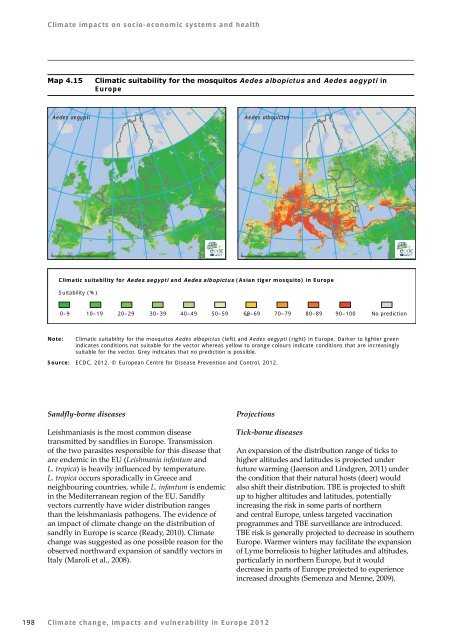Climate change, impacts and vulnerability in Europe ... - MemoFin.fr
Climate change, impacts and vulnerability in Europe ... - MemoFin.fr
Climate change, impacts and vulnerability in Europe ... - MemoFin.fr
Create successful ePaper yourself
Turn your PDF publications into a flip-book with our unique Google optimized e-Paper software.
<strong>Climate</strong> <strong>impacts</strong> on socio-economic systems <strong>and</strong> healthMap 4.15Climatic suitability for the mosquitos Aedes albopictus <strong>and</strong> Aedes aegypti <strong>in</strong><strong>Europe</strong>-30° -20° -10°Aedes aegypti0°10°20°30°40°50°60°70°-30° -20° -10° 0°Aedes albopictus10°20°30°40°50°60°70°60°60°50°50°50°50°40°40°40°40°0 500 0° 1000 150010°km20°30°40°0 500 0° 1000 150010°km20°30°40°Climatic suitability for Aedes aegypti <strong>and</strong> Aedes albopictus (Asian tiger mosquito) <strong>in</strong> <strong>Europe</strong>Suitability (%)0–9 10–19 20–29 30–39 40–49 50–59 60–69 70–79 80–89 90–100 No predictionNote:Climatic suitability for the mosquitos Aedes albopictus (left) <strong>and</strong> Aedes aegypti (right) <strong>in</strong> <strong>Europe</strong>. Darker to lighter green<strong>in</strong>dicates conditions not suitable for the vector whereas yellow to orange colours <strong>in</strong>dicate conditions that are <strong>in</strong>creas<strong>in</strong>glysuitable for the vector. Grey <strong>in</strong>dicates that no prediction is possible.Source: ECDC, 2012. © <strong>Europe</strong>an Centre for Disease Prevention <strong>and</strong> Control, 2012.S<strong>and</strong>fly-borne diseasesLeishmaniasis is the most common diseasetransmitted by s<strong>and</strong>flies <strong>in</strong> <strong>Europe</strong>. Transmissionof the two parasites responsible for this disease thatare endemic <strong>in</strong> the EU (Leishmania <strong>in</strong>fantum <strong>and</strong>L. tropica) is heavily <strong>in</strong>fluenced by temperature.L. tropica occurs sporadically <strong>in</strong> Greece <strong>and</strong>neighbour<strong>in</strong>g countries, while L. <strong>in</strong>fantum is endemic<strong>in</strong> the Mediterranean region of the EU. S<strong>and</strong>flyvectors currently have wider distribution rangesthan the leishmaniasis pathogens. The evidence ofan impact of climate <strong>change</strong> on the distribution ofs<strong>and</strong>fly <strong>in</strong> <strong>Europe</strong> is scarce (Ready, 2010). <strong>Climate</strong><strong>change</strong> was suggested as one possible reason for theobserved northward expansion of s<strong>and</strong>fly vectors <strong>in</strong>Italy (Maroli et al., 2008).ProjectionsTick-borne diseasesAn expansion of the distribution range of ticks tohigher altitudes <strong>and</strong> latitudes is projected underfuture warm<strong>in</strong>g (Jaenson <strong>and</strong> L<strong>in</strong>dgren, 2011) underthe condition that their natural hosts (deer) wouldalso shift their distribution. TBE is projected to shiftup to higher altitudes <strong>and</strong> latitudes, potentially<strong>in</strong>creas<strong>in</strong>g the risk <strong>in</strong> some parts of northern<strong>and</strong> central <strong>Europe</strong>, unless targeted vacc<strong>in</strong>ationprogrammes <strong>and</strong> TBE surveillance are <strong>in</strong>troduced.TBE risk is generally projected to decrease <strong>in</strong> southern<strong>Europe</strong>. Warmer w<strong>in</strong>ters may facilitate the expansionof Lyme borreliosis to higher latitudes <strong>and</strong> altitudes,particularly <strong>in</strong> northern <strong>Europe</strong>, but it woulddecrease <strong>in</strong> parts of <strong>Europe</strong> projected to experience<strong>in</strong>creased droughts (Semenza <strong>and</strong> Menne, 2009).198 <strong>Climate</strong> <strong>change</strong>, <strong>impacts</strong> <strong>and</strong> <strong>vulnerability</strong> <strong>in</strong> <strong>Europe</strong> 2012
















